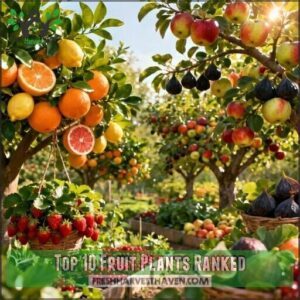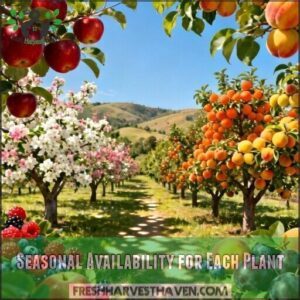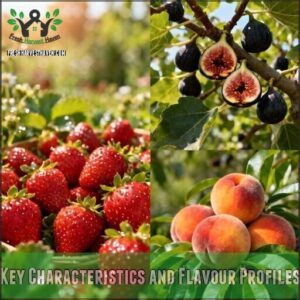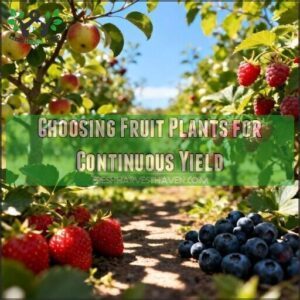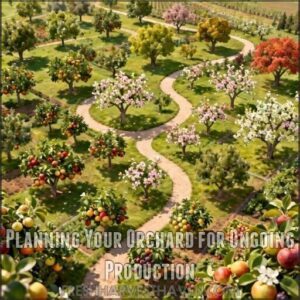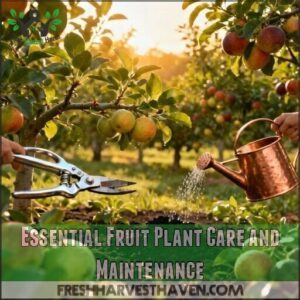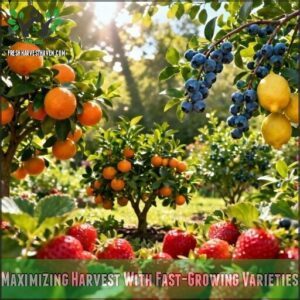This site is supported by our readers. We may earn a commission, at no cost to you, if you purchase through links.
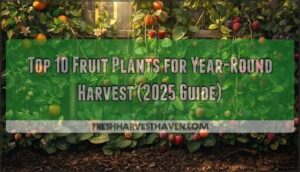 Most backyard orchards sit empty for months at a time—apples come and go in autumn, strawberries vanish by midsummer, and citrus ripens only when winter settles in. But you don’t have to accept those gaps. With the right combination of fruit plants, you can walk outside nearly any month and find something ripe on the branch.
Most backyard orchards sit empty for months at a time—apples come and go in autumn, strawberries vanish by midsummer, and citrus ripens only when winter settles in. But you don’t have to accept those gaps. With the right combination of fruit plants, you can walk outside nearly any month and find something ripe on the branch.
The secret isn’t luck or endless acreage; it’s matching botanical characteristics to your climate and staggering varieties that fruit at different times. Citrus cultivars alone can span ten months when you combine early navels with late-season Valencias, while everbearing strawberries stretch production from May clear through October.
When you understand fruiting windows, pollination needs, and how rootstock choices affect harvest timing, you’ll transform those long empty stretches into steady yields that keep your kitchen stocked and your pruning shears busy.
Table Of Contents
- Key Takeaways
- Best Fruit Plants for Year-Round Harvest
- Choosing Fruit Plants for Continuous Yield
- Planning Your Orchard for Ongoing Production
- Essential Fruit Plant Care and Maintenance
- Maximizing Harvest With Fast-Growing Varieties
- Frequently Asked Questions (FAQs)
- What fruit is grown all year round?
- What is the easiest fruit to harvest?
- What fruit trees bear fruit year-round?
- Which plant produces the most fruit?
- What fruit can grow all year round?
- What fruit can you buy all year round?
- What are the fastest yielding fruit trees?
- What is the most profitable fruit to plant?
- How to prevent fruit drop during seasonal transitions?
- What fruit plants are ideal for balconies?
- Conclusion
Key Takeaways
- Year-round harvests require strategic variety selection—pairing early, mid, and late-season cultivars of the same fruit (like combining early navels with late Valencias for citrus) lets you stretch harvest windows across ten months instead of settling for seasonal gaps.
- Rootstock choice and pollination compatibility matter as much as species selection—dwarfing rootstocks keep trees manageable at 8-12 feet while self-fertile varieties like figs and most citrus simplify small-space planning, but apples and pears need cross-pollinators within 15 meters to set fruit.
- Climate matching trumps wishful planting—citrus thrives in USDA zones 9-11, apples need winter chill in zones 3-8, and checking your microclimate for temperature extremes and moisture patterns prevents expensive failures before they happen.
- Fast-bearing grafted varieties deliver fruit in 1-3 years compared to seed-grown alternatives, with options like ‘Celeste’ fig, dwarf ‘Satsuma’ mandarin, and container-friendly ‘Pixzee’ peach turning even balconies into productive mini-orchards for impatient growers.
Best Fruit Plants for Year-Round Harvest
Planning a year-round harvest means choosing fruit plants that ripen at different times and suit your local growing conditions. You’ll want a mix of varieties that can withstand your climate while delivering consistent yields across the seasons.
Here’s a ranked list of the ten best options to keep your kitchen stocked with fresh fruit from January through December.
Top 10 Fruit Plants Ranked
If you’re serious about keeping your fruit bowl full twelve months a year, these ten plants deserve a spot in your orchard—ranked by their ability to deliver reliable harvests, adapt to varied climates, and keep your kitchen stocked when grocery store prices make you wince. Here’s how they stack up:
- Citrus varieties (Citrus spp.) lead for year-round fruit harvest potential and outstanding nutritional value
- Apple (Malus domestica) cultivars offer diverse culinary uses and varied fruit ripening and harvest times
- Fig (Ficus carica) combines compact plant size with minimal maintenance needs
- Strawberry (Fragaria × ananassa) wins every taste test with quick production and container-friendly growth
Seasonal Availability for Each Plant
Understanding harvest windows changes how you plan your orchard. Citrus delivers fruit up to ten months annually when you combine early, mid, and late cultivars—mandarins alone span March through December with the right variety mix. Apples produce from July to November, while strawberries extend May to October through everbearing types.
Regional variations matter: Valencia oranges fruit March-September in subtropical zones but only May-August in temperate areas, showing how climate impact shapes seasonal fruit availability and year-round fruit harvest success.
A fruiting calendar helps track fruit production.
Key Characteristics and Flavour Profiles
Knowing when fruit ripens matters, but taste and tree behaviour seal the deal when you’re choosing what to plant. Aromatic compounds in citrus range from floral (Meyer lemon) to intensely zesty (Eureka), while apple sweetness levels swing from tart Granny Smith to honeyed Fuji. Fruit characteristics like texture—crisp versus melting flesh—affect culinary uses and year-round fruit harvest satisfaction.
- Strawberries: bright acidity, firm texture when ripe, widely applicable for fresh eating or preserves
- Figs: jammy sweetness, soft pulp with subtle honey notes, peak flavor when slightly yielding
- Peaches: aromatic stone fruit with moderate sweetness, juicy texture ideal for canning or desserts
Choosing Fruit Plants for Continuous Yield
Getting fruit year-round isn’t just about planting different species—it’s about matching the right plants to your conditions. You’ll need to think about your climate zone, whether your chosen varieties need pollination partners, and how well they’ll stand up to local pests and diseases.
Let’s walk through the three factors that’ll make or break your continuous harvest plans.
Climate and Regional Adaptability
Your biggest challenge isn’t picking plants—it’s matching them to where you actually live. Temperature extremes dictate survival: citrus thrives in USDA hardiness zones 9–11, while apples need winter chill in zones 3–8. Rainfall patterns and humidity tolerance matter too—figs love dry heat, blueberries want consistent moisture.
For a year-round fruit harvest, study your microclimate management options and choose warm climate fruit trees or cold climate fruit trees based on seasonality effects in your region. These zones are based on average winter temperatures across North America.
Pollination Requirements and Self-Fertility
If you don’t account for pollination needs, even the healthiest tree won’t bear a single piece of fruit. Here’s what determines successful fruit set:
- Self-fertile varieties like most citrus, figs, and certain stone fruits (Prunus spp.) don’t need a cross-pollinator
- Apples (Malus domestica) and pears (Pyrus communis) require compatible pollination groups planted within 15 metres
- Pollinator attractants—native bees, flowering herbs—boost cross-pollination success rates dramatically
Check your fruit tree pollination requirements before planting. Self-fertile options simplify small spaces, but cross-pollination needs mean strategic companion planting pays off long-term.
Disease Resistance and Hardiness
Choosing cultivars with strong disease resistance and cold hardiness is like building a safety net for your orchard—you’ll spend less time treating problems and more time harvesting. Fire blight troubles 20% of growers, while rot diseases account for 25% of complaints in recent surveys. Resistant varieties like ‘Freedom’ and ‘Enterprise’ apples, ‘Kieffer’ pear, and disease-resistant plums resist common pathogens better.
Breeding for resistance has accelerated through genomic advances, yet integrated management—sanitation, virus-free rootstock, proper irrigation—still cuts disease incidence by up to 32%.
Check your USDA hardiness zone—hardy apples thrive in zone 3, blueberries and currants in zones 3–7, and hardy figs in zones 4–8. Climate adaptation matters as zones shift northward.
Planning Your Orchard for Ongoing Production
A well-planned orchard isn’t just about picking the right plants—it’s about arranging them so you’re never stuck with a gap between harvests. You’ll need to think through variety timing, how much room each tree actually needs, and which rootstocks match your goals.
Let’s break down the three key decisions that’ll keep fruit coming in from one season to the next.
Staggering Varieties for Extended Harvest
Think of your orchard as a well-rehearsed orchestra—when you select early, mid, and late-season varieties of the same fruit type, you’re basically composing a symphony of harvests that keeps your baskets full from spring through winter.
By layering early, mid, and late-season varieties of the same fruit, you compose a symphony of harvests that spans spring through winter
For apples, you might pair an ‘Early Harvest’ with a mid-season ‘Fuyu’ and a late-ripening ‘Red Delicious’ to stretch your harvest windows across several months, ensuring continuous fruit production despite shifting climate considerations.
Layout and Space Considerations
Your orchard’s footprint matters just as much as the varieties you plant—cramming trees too close together invites disease and shade-starved branches, while sprawling layouts waste precious ground and make harvest day feel like a marathon. Aim for tree spacing that respects mature size: standard apples need 15–20 feet, while dwarf varieties thrive at 8–10 feet apart, ensuring proper sunlight access throughout the canopy.
In smaller backyard orchard settings, consider vertical growth strategies like espalier or companion planting with berry shrubs beneath taller trees—container gardening with compact cultivars maximizes yield without sacrificing walkways or future expansion.
Rootstock Choices and Growth Habits
Rootstock isn’t just the underground half of your tree—it’s the invisible architect that dictates mature height, drought tolerance, and whether you’ll be pruning from a stepladder or the ground. Dwarfing rootstocks like M.26 for apples keep mature size manageable (8–12 feet), while semi-dwarf options balance vigor with disease resistance.
Check soil compatibility before grafting, since heavy clay drowns vigorous fruit trees faster than any pest ever could.
Essential Fruit Plant Care and Maintenance
Getting fruit plants in the ground is just the beginning—keeping them healthy and productive takes the right care at the right time. From soil prep to seasonal pruning, these maintenance practices directly impact how much fruit you’ll harvest.
Let’s break down the essentials you need to focus on.
Watering, Fertilizing, and Soil Preparation
Healthy roots don’t grow in neglected soil—getting your watering schedule, nutrient balance, and substrate right from the start makes the difference between a struggling tree and one that pumps out fruit like clockwork. Most fruit trees need deep, infrequent watering techniques that encourage roots to dive rather than spread shallow.
Test your pH balance annually—citrus prefers slightly acidic conditions around 6.0, while stone fruits tolerate 6.5-7.0. Mix compost and aged manure as soil amendments before planting, then apply balanced fertilizer types (like 10-10-10) in early spring.
Don’t forget drainage solutions—raised beds work wonders if your site holds water.
Pruning Techniques for Maximum Yield
Sharp pruning shears do more for your harvest than any fertilizer ever could—a few well-placed cuts redirect energy from leafy growth straight into fruit production. Prune during dormancy for stone fruits, late winter for apples (Malus domestica).
Remove crossed branches and select outward-facing buds to shape growth habit. Regular tool maintenance prevents disease spread.
Master these fruit tree pruning techniques and watch yield optimization follow naturally—year-round fruit harvest starts with understanding when and where to cut.
Pest and Disease Management
Even the healthiest pruned trees won’t produce much if aphids, fungal spores, or codling moths decide your orchard is their all-you-can-eat buffet. Start with pest identification—know your enemy before reaching for sprays.
Integrated management combines organic controls like neem oil with seasonal spraying schedules. Disease prevention beats cure every time: choose varieties with built-in disease resistance and practice proper fruit tree maintenance year-round.
Maximizing Harvest With Fast-Growing Varieties
If you’re keen to see results without the wait, fast-growing varieties are your best friends. Some fruit plants bear crops in just one or two years, while others offer compact growth perfect for tight spaces.
Here’s how to choose varieties that’ll get you harvesting sooner and keep the bounty coming.
Quick-Bearing Fruit Trees and Shrubs
If you’re keen for a year-round fruit harvest without the wait, fast-growing fruit trees can deliver results in record time. Grafted varieties like ‘Celeste’ fig and ‘Redhaven’ peach start fruiting within 1-3 years, far outpacing seed-grown alternatives. Raspberries produce berries in their first season, while dwarf citrus like ‘Satsuma’ mandarin bring harvest season indoors with container growing.
Cold tolerance varies—’Kazake’ pomegranate thrives in zones 4-10, whereas tropical guava needs frost-free conditions. Many are self-fertile, simplifying pollination needs and speeding fruit ripening for impatient orchardists.
Container and Dwarf Options for Small Spaces
Balconies, courtyards, and patios don’t have to miss out—container-grown dwarf fruit trees make year-round harvest possible even when ground space is at a premium. Dwarf varieties like ‘Pixzee’ peach (Prunus persica) and ‘Improved Meyer’ lemon (Citrus × meyeri) thrive in 15-20 gallon pots, turning balcony orchards into productive mini-farms.
Space optimization is key—espalier training against sunny walls maximizes patio fruits while blueberries (Vaccinium spp.) love acidic potting mix in containers.
Tips for Early and Prolonged Fruit Production
When you want fruit sooner rather than later—and for as long as possible, strategic timing through variety selection and smart cultivation techniques can stretch your harvest window by months. Optimizing pollination with overlapping bloom times boosts fruit yields, while pruning strategies encourage earlier bearing.
Strong soil health and consistent irrigation techniques support healthy fruit production. Stagger ripening times across early, mid, and late-season cultivars for year-round fruit harvest that keeps your basket full from spring through winter.
Frequently Asked Questions (FAQs)
What fruit is grown all year round?
You might think tropical fruits dominate year-round production, but in reality, citrus—especially lemons and limes—deliver consistent harvests across growing seasons when multiple grafting techniques and climate considerations align, making them ideal for year-round fruit production through staggered indoor growing and strategic storage options.
What is the easiest fruit to harvest?
Strawberries top the list for harvesting ease. You’ll find accessibility concerns minimal—plant height considerations work in your favor since berries sit close to ground level.
There’s no thorns and prickles to navigate, and fruit size impact means you can pick quickly without careful treatment.
What fruit trees bear fruit year-round?
True year-round fruit production seems impossible—yet tropical fruiting trees like citrus in subtropical climates defy fruit seasonality through continuous bloomers and climate control. Grafting techniques and indoor fruiting extend harvests, though most fruit tree varieties still follow seasonal cycles rather than achieving genuine year-round fruit production.
Which plant produces the most fruit?
Raspberries lead in yield comparison for smaller spaces, producing up to 5kg per plant with exceptional fruiting frequency.
For year-round fruit production, citrus varieties and fig trees deliver consistent harvest weight while maintaining strong space efficiency and plant longevity across multiple seasons.
What fruit can grow all year round?
Citrus fruits like lemons (Citrus limon) and limes are preeminent for year-round fruit production in warm climates, continuously flowering and fruiting across seasons.
Indoor growing and hydroponic systems extend this advantage to cooler zones, enabling continuous harvesting of year-round cultivars regardless of outdoor conditions.
What fruit can you buy all year round?
Global fruit trade and modern storage methods mean you can buy bananas, apples, and oranges year-round in most fruit markets.
Transportation networks and cultivation practices across hemispheres make certain seasonal fruits from one region fill gaps elsewhere, creating consistent fruit availability despite natural harvest cycles.
What are the fastest yielding fruit trees?
Grafted dwarf varieties like Meyer Lemon and Calamansi yield fruit within one to two years—faster than a telegram delivery.
Cutting propagation shortens the fruiting timeframe for Loquats, while Figs and Apricots deliver subtropical options in two to five years, perfect for year-round fruit harvest planning.
What is the most profitable fruit to plant?
Profitability hinges on market demand and yield potential balanced against input costs. High-value fruit varieties like blueberries, raspberries, and certain citrus trees often command premium prices, though price volatility and processing options matter.
Your year-round fruit harvest strategy should prioritize fruit production that matches local demand while minimizing risks.
How to prevent fruit drop during seasonal transitions?
Seasonal stress often triggers premature fruit drop, but you can minimize losses through consistent fruit tree watering and balanced nutrient management.
Temperature fluctuations disrupt pollination, so protect blossoms during cold snaps and maintain vigilant pest control to reduce stress that compromises fruit tree yields.
What fruit plants are ideal for balconies?
Dwarf varieties and container suitability make balcony fruit gardening achievable.
Blueberries, figs, and strawberries thrive in pots with proper sunlight needs and watering needs, overcoming space constraints while delivering fresh harvests.
Conclusion
You might think year-round harvests demand a greenhouse or tropical paradise, but the top 10 fruit plants for year-round harvest thrive in most temperate zones when you pair early and late cultivars. The real work lies in choosing varieties whose fruiting windows overlap—citrus bridging winter, everbearing berries through summer, and late apples carrying you into frost.
Match those botanical rhythms to your hardiness zone, and those empty months disappear. Your orchard becomes a timed relay where one harvest hands off to the next.
- https://edis.ifas.ufl.edu/publication/MG054
- https://www.researchgate.net/publication/370781176_CULTIVATION_PACKAGE_OF_PAPAYA
- https://www.mygarden.co.nz/optimal-fig-tree-growth-soil-sunlight-and-climate-tips/
- https://www.cabidigitallibrary.org/doi/full/10.1079/cabicompendium.24078
- https://resprout.com/read-this-before-you-plant-a-fig-tree-in-ground/

